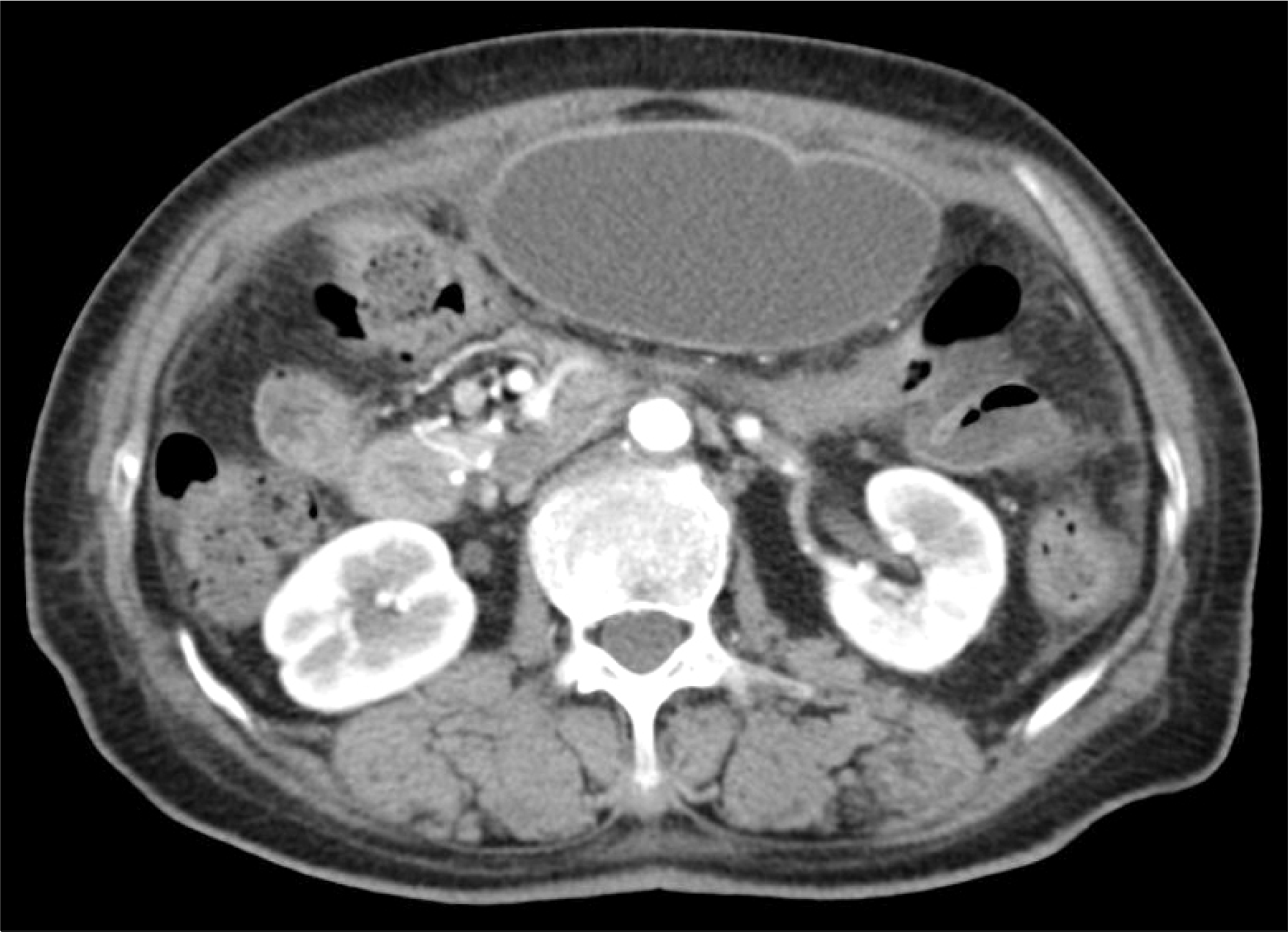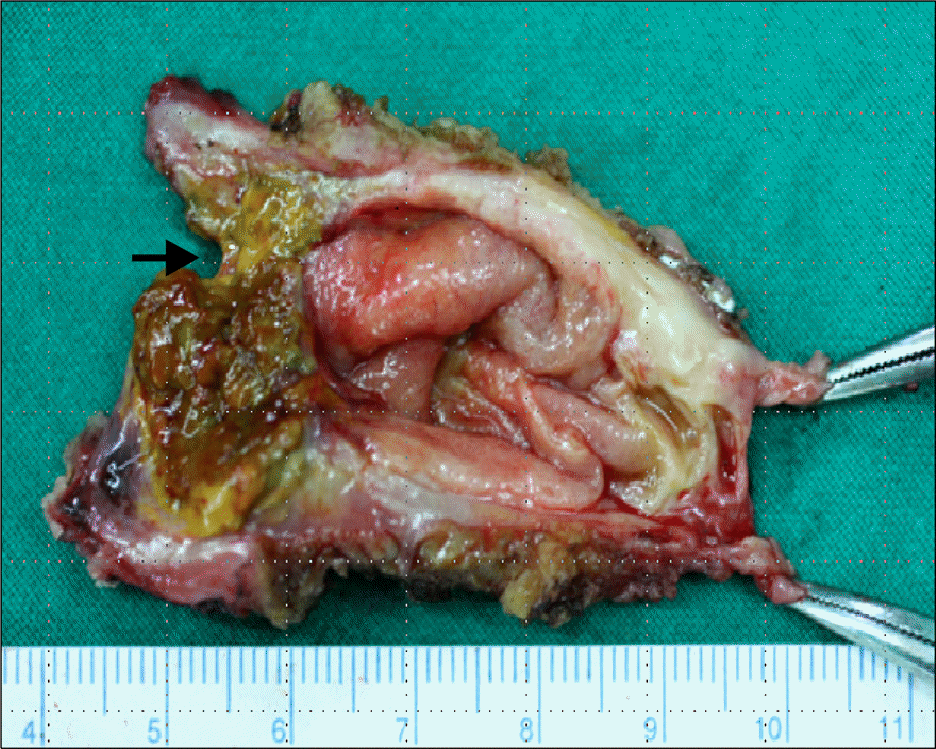Abstract
Xanthogranulomatous cholecystitis is an unusual inflammatory disease of the gallbladder characterized by severe proliferative fibrosis and the accumulation of lipid-laden macrophages in areas of destructive inflammation. Its macroscopic appearance may occasionally be confused with gallbladder carcinoma. We present a case of perforated xanthogranulomatous cholecystitis presenting as biloma. An 80-year-old woman was referred to our hospital with a 1-week history of abdominal pain and febrile sensation. Abdominal CT showed a biloma in the subhepatic area. The follow-up CT showed that the biloma increased in size. Therefore, ultrasonography-guided aspiration was performed. The aspirated fluid/serum bilirubin ratio was greater than 5, which was strongly suggestive of bile leakage complicated by perforated cholecystitis. She underwent a laparoscopic cholecystectomy with cyst aspiration and adhesiolysis. A histological diagnosis of perforated xanthogranulomatous cholecystitis was made.
Go to : 
References
1. Hanada K, Nakata H, Nakayama T, et al. Radiologic findings in xanthogranulomatous cholecystitis. AJR Am J Roentgenol. 1987; 148:727–730.

2. Parra JA, Acinas O, Bueno J, Güezmes A, Fernández MA, Fariñas MC. Xanthogranulomatous cholecystitis: clinical, sonographic, and CT findings in 26 patients. AJR Am J Roentgenol. 2000; 174:979–983.
3. Roberts KM, Parsons MA. Xanthogranulomatous cholecystitis: clinicopathological study of 13 cases. J Clin Pathol. 1987; 40:412–417.

4. Seo SH, Park JI, Kim JS, Kim KH, Choi CS, Choi YK. Xanthogranulomatous cholecystitis: a retrospective analysis of 36 cases. J Korean Surg Soc. 2009; 76:371–377.

5. Kim HY, Cho YH, Park JH. Xanthogranulomatous cholecystitis not associated with gallstone in a 9-year-old girl. J Korean Surg Soc. 2009; 77:72–74.

6. Joo YE, Lee JJ, Chung IJ, et al. A case of xanthogranulomatous cholecystitis. Korean J Intern Med. 1999; 14:90–93.

7. Kim DS, Choi DY, Kim YS, et al. A case of xanthogranulomatous cholecystitis associated with Mirizzi syndrome. Korean J Gastroenterol. 1999; 34:136–141.
8. Kim PN, Ha HK, Kim YH, Lee MG, Kim MH, Auh YH. US findings of xanthogranulomatous cholecystitis. Clin Radiol. 1998; 53:290–292.

9. Kim KH, Ahn CH, Kim JS, et al. Xanthogranulomatous cholecystitis mimicking gallbladder cancer. J Korean Surg Soc. 2002; 63:441–444.
10. Lee HS, Joo KR, Kim DH, et al. A case of simultaneous xanthogranulomatous cholecystitis and carcinoma of the gallbladder. Korean J Intern Med. 2003; 18:53–56.

11. Houston JP, Sampson MA, Collins MC. Ultrasound diagnosis of gallbladder perforation in a case of xanthogranulomatous cholecystitis. Br J Radiol. 1989; 62:273–274.

12. Hsu C, Hurwitz JL, Schuss A, Katz DS. Radiology-pathology conference: xanthogranulomatous cholecystitis. Clin Imaging. 2003; 27:421–425.
13. Khan SA, Gulfam , Anwer AW, Arshad Z, Hameed K, Shoaib M. Gallbladder perforation: a rare complication of acute cholecystitis. J Pak Med Assoc. 2010; 60:228–229.
14. Darwin P, Goldberg E, Uradomo L. Jackson Pratt drain fluid-to-serum bilirubin concentration ratio for the diagnosis of bile leaks. Gastrointest Endosc. 2010; 71:99–104.

15. Runyon BA. Ascitic fluid bilirubin concentration as a key to choleperitoneum. J Clin Gastroenterol. 1987; 9:543–545.

16. Welsch T, von Frankenberg M, Schmidt J, Büchler MW. Diagnosis and definition of anastomotic leakage from the surgeon's perspective. Chirurg. 2011; 82:48–55.
Go to : 
 | Fig. 1.CT scan of abdomen. It showed a focal gallbladder wall thickening and fluid collection in the subhepatic space. There was no definitive connection between the fluid collection and the gallbladder. |
 | Fig. 2.Follow-up CT scan of abdomen. It showed that the cystic mass increased in size (11×5 cm) with wall enhancement in the subhepatic space. |
 | Fig. 3.Gross findings of the specimen. The gallbladder was characterized by a thickened wall with poorly circumscribed yellowish granular necrotic areas and perforation (arrow). |
 | Fig. 4.Microscopic findings of the specimen. (A) The ulcerated mucosa of the gallbladder was stained with bile pigments (H&E stain, ×40). (B) The subepithelial connective tissue of the gallbladder showed a massive aggregation of foamy macrophages. There were also infiltration of lymphocytes, plasma cells and occasional multinucleated giant cells. Many macrophages contained both ceroid pigments and cholesterol (H&E stain, ×400). |




 PDF
PDF ePub
ePub Citation
Citation Print
Print


 XML Download
XML Download